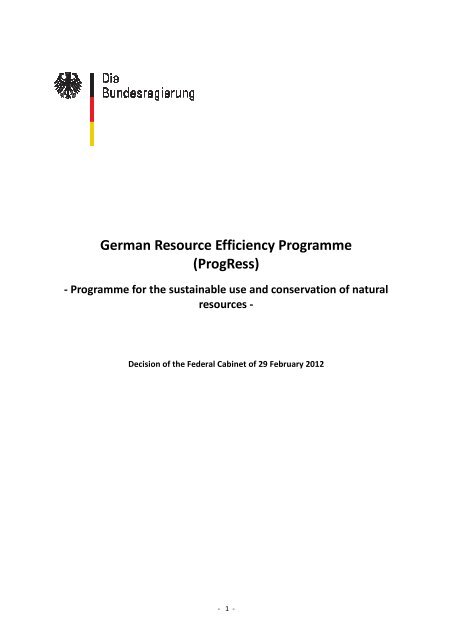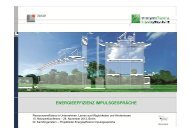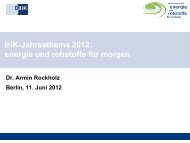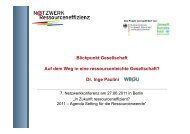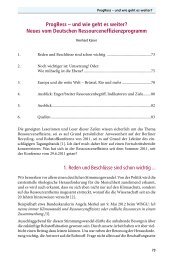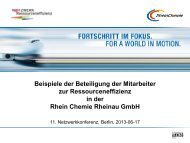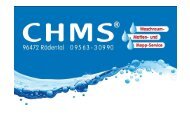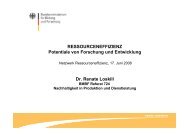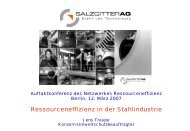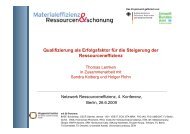German Resource Efficiency Programme (ProgRess)
German Resource Efficiency Programme (ProgRess)
German Resource Efficiency Programme (ProgRess)
You also want an ePaper? Increase the reach of your titles
YUMPU automatically turns print PDFs into web optimized ePapers that Google loves.
<strong>German</strong> <strong>Resource</strong> <strong>Efficiency</strong> <strong>Programme</strong><br />
(<strong>ProgRess</strong>)<br />
- <strong>Programme</strong> for the sustainable use and conservation of natural<br />
resources -<br />
Decision of the Federal Cabinet of 29 February 2012<br />
- 1 -
Compiled pursuant to Cabinet decision of 20 October 2010 on the <strong>German</strong> Government's<br />
Raw Materials Strategy, based on the National Sustainability Strategy "Perspectives for<br />
<strong>German</strong>y" of 17 April 2002 and the “Thematic Strategy for the Sustainable Use of Natural<br />
<strong>Resource</strong>s” of the Commission of the European Union of 21 December 2005.<br />
Published by:<br />
Federal Ministry for the Environment, Nature Conservation and Nuclear Safety (BMU), Berlin<br />
11055 Berlin<br />
E-Mail: service@bmu.de, Internet: www.bmu.de<br />
Editors:<br />
Reinhard Kaiser (BMU, WA III), Anne Miehe, Birgit Schwenk (BMU, WA III 1)<br />
Cover: Pete Leonard / Corbis<br />
Taken from the VDI-ZRE campaign: www.das-zahlt-sich-aus.de<br />
As at:<br />
29 February 2012 Version 4.0.3<br />
- 2 -
Contents<br />
Preface<br />
Part I General Information on the <strong>Programme</strong><br />
1. <strong>Resource</strong> efficiency - challenge and opportunity<br />
1.1 Combining diverse activities: a programme for resource efficiency<br />
1.2 Focus of the programme: efficient management of raw materials<br />
1.3 Other resources and their uses<br />
• Water<br />
• Soil and land<br />
• Air<br />
• Biological diversity<br />
• Biotic raw materials as fuel or food and feedstuff<br />
2. Where do we stand?<br />
2.1 More growth, prosperity, quality of life - an increasing burden on the environment<br />
2.2 The economic potential of resource efficiency<br />
2.3 <strong>Resource</strong> conservation - an important task for policy-makers<br />
2.4 Current activities in <strong>German</strong>y - a wide range of initiatives<br />
3. Guiding principles and objectives<br />
3.1 Four guiding principles for the approach and angle taken<br />
• Joining ecological necessities with economic opportunities,<br />
innovation support and social responsibility.<br />
• Viewing global responsibility as a key focus of our national resource policy.<br />
• Gradually making economic and production practices in <strong>German</strong>y less dependent<br />
on primary resources, developing and expanding closed cycle management.<br />
• Securing sustainable resource use for the long term by guiding society towards<br />
quality growth.<br />
3.2 Indicators and objectives for decisions directed at efficiency<br />
• Inclusion of raw material equivalents of imports<br />
• Consideration of per capita domestic resource consumption<br />
• Mapping of unused material extraction<br />
• Contribution of closed cycle management: Consideration of cascade use and<br />
recycling<br />
- 3 -
Part II Strategic approaches along the entire value chain<br />
1. Securing a sustainable raw material supply<br />
Approach 1: Implementation and development of the Federal Government's Raw<br />
Materials Strategy<br />
Approach 2: Targeted expansion of the use of renewable resources as materials<br />
2. Raising resource efficiency in production<br />
Approach 3: Boosting innovation and competitiveness by strengthening efficiency<br />
advice for companies<br />
Approach 4: Development and dissemination of resource- and energy-efficient<br />
production and processing methods<br />
Approach 5: Information on and promotion of the use of environmental<br />
management systems<br />
Approach 6: Innovation through the integration of resource efficiency into product<br />
design<br />
Approach 7: Integration of resource conservation into standardisation<br />
3. Making consumption more resource-efficient<br />
Approach 8: Creating public awareness<br />
Approach 9: <strong>Resource</strong> efficiency as a criterion for trade and consumer decisions<br />
Approach 10: Introduction of new certification schemes, greater use of existing<br />
schemes for raw materials<br />
Approach 11: Increased use of public procurement as an instrument of resource<br />
efficiency<br />
4. Enhancing resource-efficient closed cycle management<br />
Approach 12: Reinforcing product responsibility<br />
Approach 13: Optimising collection and recycling of resource-relevant bulk wastes<br />
- 4 -
Approach 14: Ban on illegal exports, supporting waste recovery structures in newly<br />
industrialising and developing countries<br />
5. Using overarching instruments<br />
Approach 15: Strengthening instruments for improving market penetration of<br />
resource-efficient products and services<br />
Approach 16: Using economic instruments and dismantling subsidies which<br />
encourage resource consumption<br />
Approach 17: Strengthening research and improving the knowledge base<br />
Approach 18: Considering resource efficiency in the further development of the legal<br />
framework at national level<br />
Approach 19: Technology and knowledge transfer, expert advice<br />
Approach 20: Further developing the political and legal framework at EU level and in<br />
an international context<br />
Part III Specific examples<br />
1. Sectoral examples<br />
Example 1: Bulk metals<br />
Example 2: Rare earths and critical metals<br />
Example 3: Sustainable planning, construction and use of buildings and<br />
structures<br />
Example 4: <strong>Resource</strong> efficiency in future technologies - the example of<br />
photovoltaics<br />
Example 5: <strong>Resource</strong> efficiency in future technologies - the example of<br />
Electric mobility<br />
Example 6: Green IT: <strong>Resource</strong> efficiency in information and communication<br />
technology (ICT)<br />
Example 7: Renewable raw materials in the chemical industry<br />
2. Examples of material flows relevant to resource conservation<br />
Material flow 1: Phosphorous<br />
Material flow 2: Indium<br />
Material flow 3: Gold<br />
Material flow 4: Plastic waste<br />
- 5 -
IV. Annex<br />
1. Activities of the Federal Government<br />
2. Activities of the Länder<br />
3. Activities of associations and institutions<br />
- 6 -


